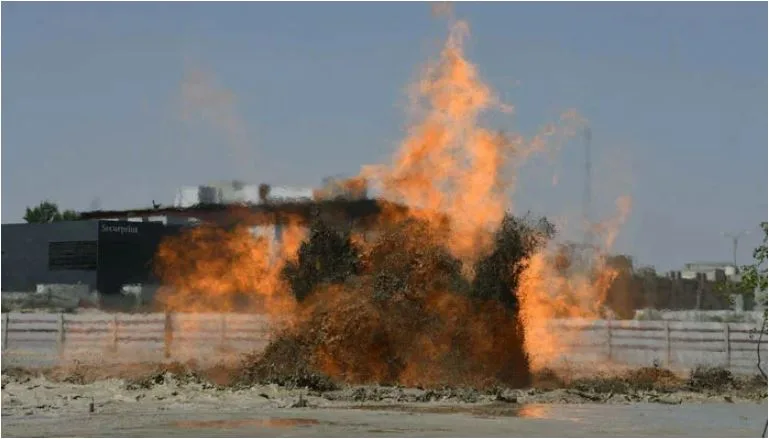KARACHI: The massive fire that raged for more than two weeks in Karachi’s Korangi area has finally been extinguished. However, gas emission from the site still continues, raising ongoing safety concerns.
The blaze broke out on March 29 after a deep bore-drilling operation went 1,200 feet underground. Since then, thick smoke and flames alarmed nearby residents and drew national attention.
Authorities confirmed that the fire has gone out, but gas is still escaping from the pit. This gas is causing water, used earlier by firefighters, to erupt from the site.
Chief Fire Officer Humayun Khan said the fire burned out on its own. He confirmed the presence of a gas pocket beneath the surface. “Such natural gas incidents are not unusual in Sui, Balochistan,” he added.
Fortunately, there were no casualties. Khan said fire brigade teams remain stationed at the site due to the strong gas odor spreading across the area.
Us-Based Emergency Response Firm Consulted
Meanwhile, the Ministry of Petroleum launched a formal investigation into the incident. Experts from Cudd Well Control, a US-based emergency response firm, were consulted for their expertise in managing gas well fires.
Technical teams from Pakistan Petroleum Limited (PPL) and United Energy Pakistan Limited also visited the site. Their specialists included drilling, completions, and environmental safety experts.
Initial observations indicated the fire intensity had not decreased for days, pointing to a large underground gas reserve. The crater created by the incident has expanded due to sand loosening and water overflow. Hot water and visible vapors continue to flow from the site.
Preliminary water testing conducted by PPL revealed alarming results. The analysis showed excessive levels of hazardous chemicals including benzene, toluene, and tetrachloroethylene.
Experts measured benzene at 19 milligrams per litre—almost four times higher than the safety limit of 5 mg/l. They found toluene at 15 mg/l, while tetrachloroethylene reached 33 micrograms per litre, far exceeding the allowed limit of 5 mg/l.
They also detected o-xylene in slightly elevated amounts, though they did not reveal the exact quantity. Despite the presence of these chemicals, experts confirmed that the overall hydrocarbon levels in the water remained within permissible limits.
They believe the contamination likely resulted from the type of gas involved in the fire or from substances used during the bore-drilling process.
Authorities continue to monitor the situation closely. Officials said further studies will determine the long-term environmental impact of the fire and the ongoing gas leak.
Local residents remain concerned about health risks. Authorities have yet to announce any evacuation or health safety measures.
The origin of the gas and reasons for its release during drilling remain under investigation. In the meantime, experts are working to contain the emissions and prevent further environmental damage.
This incident marks one of Karachi’s most mysterious and hazardous underground fires in recent years.
Follow us on Google News, Instagram, YouTube, Facebook, Whats App, and TikTok for latest updates
